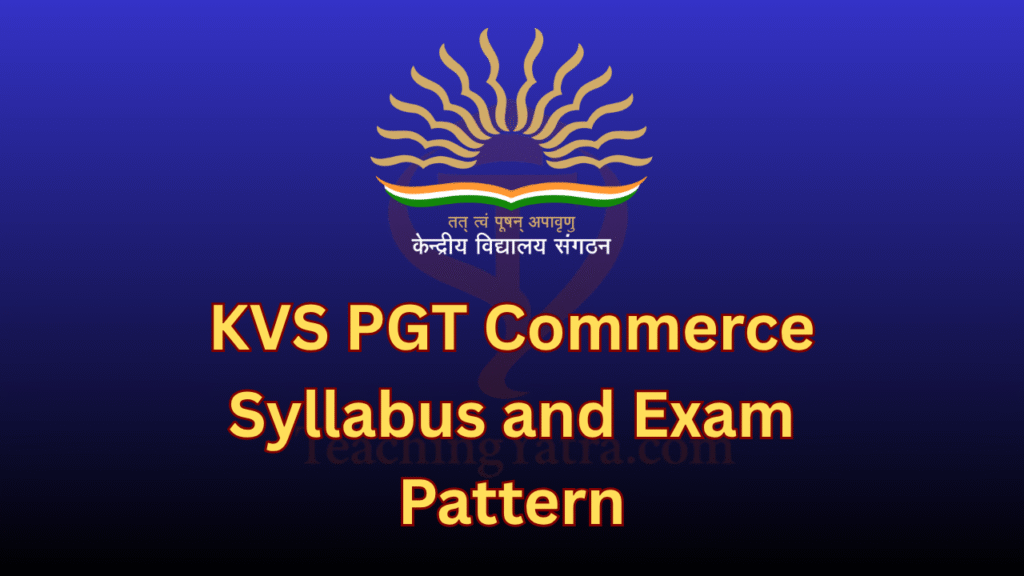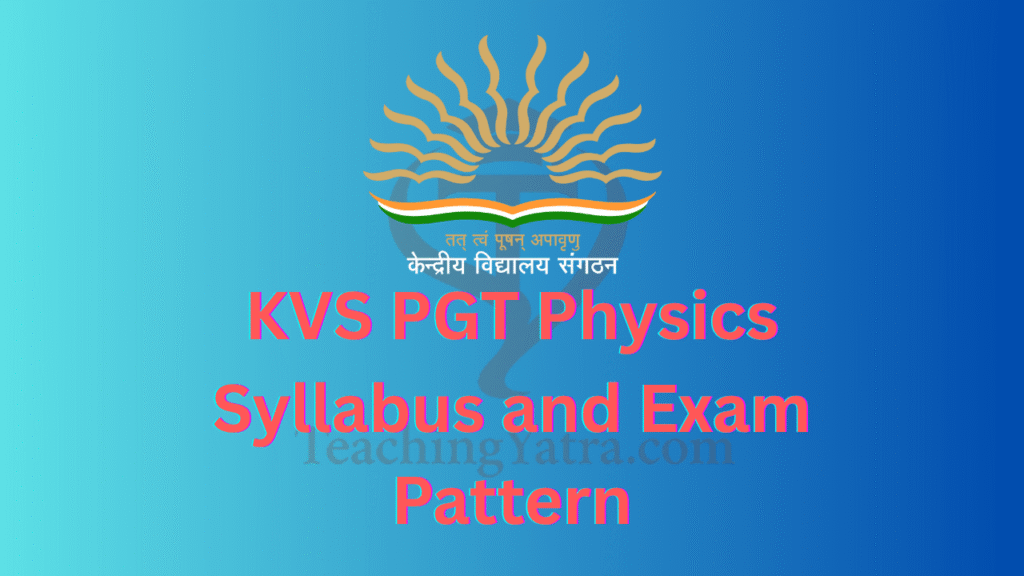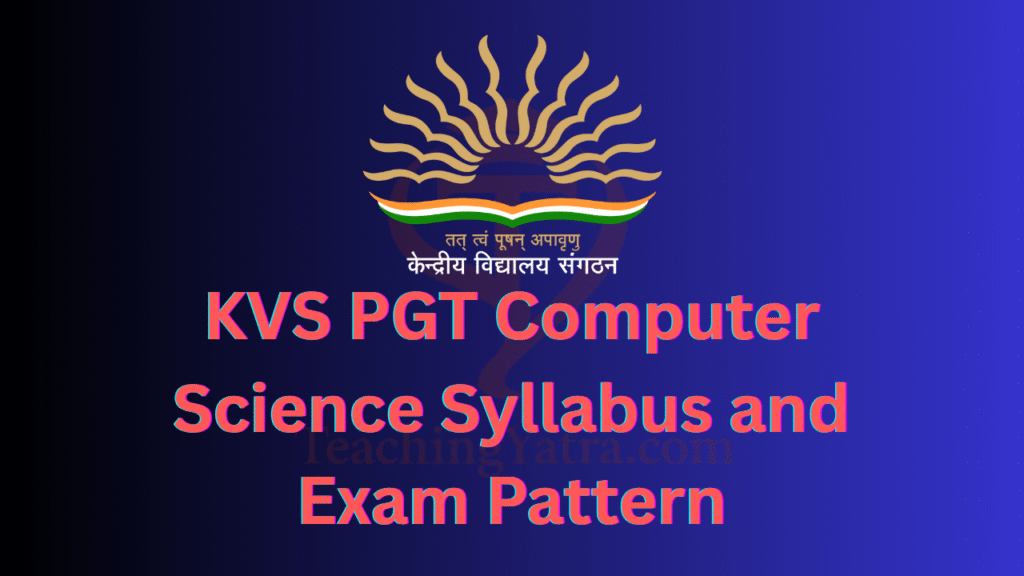
KVS PGT Commerce Syllabus 2025 is the first step to begin your exam preparation effectively. It includes important topics, marking scheme, and exam pattern that help you plan a focused study strategy. Download the complete syllabus PDF and start your preparation today.
Aspirants preparing for the KVS PGT Commerce Exam 2025 must thoroughly understand the official syllabus released by Kendriya Vidyalaya Sangathan (KVS). A clear grasp of the syllabus ensures better time management, targeted preparation, and increased chances of success. Use the syllabus to build a structured, topic-wise study plan for the upcoming Commerce PGT recruitment.
Table of Contents
KVS PGT Commerce Syllabus: Overview
KVS PGT Commerce Syllabus 2025 outlines the crucial subjects and topic areas that aspirants must study to crack the Kendriya Vidyalaya Sangathan (KVS) recruitment exam for PGT Commerce. Staying updated with the official syllabus and notifications is vital for smart and effective preparation. A clear understanding of the latest syllabus allows candidates to build a structured, topic-wise study plan that enhances performance and increases their chances of success in the exam. Follow a focused strategy aligned with the syllabus to confidently aim for the PGT Commerce post.
KVS PGT Commerce Exam Pattern 2025
Understanding the KVS PGT Commerce Exam Pattern 2025 is key for thorough and strategic preparation. It gives insights into question types, total marks, time duration, and subject-wise weightage. Knowing the pattern helps candidates plan better and manage time efficiently in the actual exam. Check the full structure below
KVS PGT Commerce Marks Distribution 2025
The exam is divided into four parts covering seven components. Here’s the section-wise mark distribution:
| KVS Exam Section | Subjects | No. of Questions | Marks |
|---|---|---|---|
| PART-I | General English | 10 | 10 |
| General Hindi | 10 | 10 | |
| PART-II | General Awareness & Current Affairs | 10 | 10 |
| Reasoning Ability | 5 | 5 | |
| Computer Literacy | 5 | 5 | |
| PART-III | Perspectives on Education & Leadership | 40 | 40 |
| PART-IV | Commerce (Subject Concerned) | 100 | 100 |
| Total | — | 180 | 180 |
This well-structured pattern ensures that candidates are evaluated across both general and subject-specific knowledge, helping selectors choose the most capable individuals for the PGT Commerce role in KVS.
Detailed KVS PGT Commerce (Accountancy & Business Studies) Syllabus 2025
Subject specific syllabus includes the concepts of NCERT/CBSE syllabus and Text Books (Classes XI & XII), however, the questions will be testing the depth of understanding and application of these concepts at the level of Post- Graduation.
A. Accountancy
Introduction to Accounting
- Accounting: concept, meaning, as a source of information; objectives, advantages and limitations; types of accounting information; users of accounting information and their needs. Qualitative characteristics of accounting information. Role of accounting in business.
- Basic Accounting Terms: Business transaction, entity, capital, drawings, liabilities (non-current and current), assets (non-current, current), fixed assets (tangible and intangible), expenditure (capital and revenue), expense, revenue, income, profit, gain, loss, purchase, sales, goods, stock, debtor, creditor, voucher, discount (trade discount and cash discount).
Theory Base of Accounting
- Fundamental accounting assumptions: GAAP: concept
- Concepts: Business entity, money measurement, going concern, accounting period, cost concept, dual aspect, revenue recognition, matching, full disclosure, consistency, conservatism, materiality, and objectivity.
- System of Accounting; Basis of Accounting: Cash basis and accrual basis.
- Accounting Standards: Applicability in IndAS.
- Goods and Services Tax (GST): Characteristics and advantages.
Recording of Business Transactions
- Vouchers and transactions: Source documents and vouchers, preparation of vouchers, accounting equation approach: meaning and analysis, rules of debit and credit.
- Recording of Transactions: Books of original entry – journal
- Special Purpose Books:
- Cash Book: Simple, cash book with bank column, petty cashbook
- Purchases book
- Sales book
- Purchases return book
- Sales return book
- Journal proper
- Ledger: Format, posting from journal and subsidiary books, balancing of accounts.
- Bank Reconciliation Statement: Need and preparation, BRS with adjusted cash book.
Depreciation, Provisions and Reserves
- Depreciation: Meaning, features, need, causes, factors
- Similar terms: Depletion and amortisation
- Methods of Depreciation:
- Straight Line Method (SLM)
- Written Down Value Method (WDV)
- Difference and advantages of SLM and WDV
- Accounting treatment of depreciation:
- Charging to asset account
- Creating provision for depreciation/accumulated depreciation account
- Treatment for disposal of asset
- Provisions and reserves: Difference
- Types of reserves:
- Revenue reserve
- Capital reserve
- General reserve
- Specific reserve
- Secret reserve
- Difference between capital and revenue reserve
Trial Balance and Rectification of Errors
- Trial balance: Objectives, meaning, preparation
- Errors: Types – errors of omission, commission, principles, compensating; their effect on trial balance. Detection and rectification of errors; preparation of suspense account.
Financial Accounting – II
- Financial statements: Meaning, objectives, importance; revenue and capital receipts; revenue and capital expenditure; deferred revenue expenditure
- Trading and Profit & Loss account: Gross profit, operating profit, net profit, preparation
- Balance sheet: Need, grouping, marshalling of assets and liabilities, preparation
- Adjustments: Closing stock, outstanding expenses, prepaid expenses, accrued income, income received in advance, depreciation, bad debts, provision for doubtful debts, discount on debtors, abnormal loss, goods for personal use/staff welfare, interest on capital, manager’s commission
- Final accounts of sole proprietorship with adjustments
Accounting for Partnership Firms
- Partnership: Features, partnership deed, Indian Partnership Act provisions in absence of deed
- Capital accounts: Fixed vs fluctuating, Profit and Loss Appropriation Account, division of profit, profit guarantee
- Past adjustments: Interest on capital/drawings, salary, profit-sharing ratio
- Goodwill: Meaning, nature, need, factors, valuation methods – average profit, super profit, capitalization
Reconstitution and Dissolution of Partnership
- Change in profit-sharing ratio: Sacrificing ratio, gaining ratio, revaluation of assets, reassessment of liabilities, treatment of reserves, accumulated profits/losses, revaluation account, balance sheet
- Admission of partner: Change in ratio, goodwill (AS 26), revaluation of assets/liabilities, reserves and profits/losses, capital adjustment, capital/current accounts, balance sheet
- Retirement/death of a partner: Effect on ratio, goodwill, revaluation, accumulated profits/losses, capital adjustments, preparation of relevant accounts
- Dissolution: Meaning, types, settlement of accounts, realization account, capital accounts, cash/bank account (excluding piecemeal, company sale, insolvency)
Accounting for Share Capital
- Companies: Features, types
- Share & Share Capital: Nature, types
- Accounting: Issue and allotment of shares – equity & preference, over/under subscription, par/premium issue, calls in advance/arrears, consideration other than cash
- Concepts: Private placement, ESOP, sweat equity
- Forfeiture & reissue of shares, disclosure in balance sheet
Accounting for Debentures
- Debentures: Meaning, types
- Issue: At par/premium/discount, for non-cash consideration, with redemption terms, as collateral, interest
- Writing off: Discount/loss on issue of debentures
Financial Statements of a Company
- Meaning, nature, uses, importance
- Statement of Profit & Loss and Balance Sheet (Schedule III – Companies Act, 2013)
- Financial Statement Analysis: Meaning, significance, objectives, limitations
- Tools: Cash flow analysis, ratio analysis
Accounting Ratios
- Meaning, objectives, advantages, classification, computation
- Liquidity Ratios: Current ratio, quick ratio
- Solvency Ratios: Debt-equity, total asset to debt, proprietary, interest coverage, debt to capital employed
- Activity Ratios: Inventory turnover, receivables turnover, payables turnover, fixed asset turnover, net asset turnover, working capital turnover
- Profitability Ratios: Gross profit, operating, operating profit, net profit, return on investment
Cash Flow Statement
- Meaning, objectives, benefits
- Cash and cash equivalents
- Classification of activities and preparation
B. Business Studies
Foundation of Business
• Meaning and features
• Evolution and Fundamentals of Business
• History of Trade and Commerce in India: Indigenous Banking System, Rise of Intermediaries, Transport, Trading Communities: Merchant Corporations, Major Trade Centres, Major Imports and Exports, Position of Indian Sub-Continent in the World Economy
• Business – meaning and Characteristics, Business-Profession and Employment – Concept
• Objectives of Business
• Classification of Business Activities – Industry and Commerce
• Industry-types: Primary, Secondary, Tertiary – Meaning and Subgroups
• Commerce – Trade (types: Internal, External; Wholesale and Retail) and Auxiliaries to Trade (Banking, Insurance, Transportation, Warehousing, Communication, Advertising) – Meaning
• Business Risk – Concept
Forms of Business Organizations
• Sole Proprietorship – Concept, Merits and Limitations
• Partnership – Concept, Types, Merits and Limitations, Registration of a Partnership Firm, Partnership Deed, Types of Partners
• Hindu Undivided Family Business – Concept
• Cooperative Societies – Concept, Merits and Limitations
• Company – Concept, Merits and Limitations; Types: Private, Public and One Person Company – Concept
• Formation of Company – Stages, Important Documents
• Choice of Form of Business Organization
Public, Private and Global Enterprises
• Public Sector and Private Sector Enterprises – Concept
• Forms of Public Sector Enterprises: Departmental Undertakings, Statutory Corporations, Government Company
• Global Enterprises – Features
• Public Private Partnership – Concept
Business Services
• Business Services – Meaning and Types
• Banking: Types of Bank Accounts – Savings, Current, Recurring, Fixed Deposit, Multiple Option Deposit Account
• Banking Services – Bank Draft, Overdraft, Cash Credit
• E-Banking – Meaning, Types of Digital Payments
• Insurance – Principles, Types: Life, Health, Fire, Marine – Concept
• Postal Services – Mail, Registered Post, Parcel, Speed Post, Courier – Meaning
Emerging Modes of Business
• E-Business – Concept, Scope, Benefits
Social Responsibility of Business and Business Ethics
• Concept of Social Responsibility
• Responsibility Towards Owners, Investors, Consumers, Employees, Government, Community
• Role of Business in Environmental Protection
• Business Ethics – Concept and Elements
Finance and Trade – Sources of Business Finance
• Concept of Business Finance
• Owners’ Funds – Equity Shares, Preference Shares, Retained Earnings
• Borrowed Funds – Debentures, Bonds, Loans from Financial Institutions and Banks, Public Deposits, Trade Credit, Inter Corporate Deposits (ICD)
Small Business and Enterprises
• Entrepreneurship Development – Concept, Characteristics, Need
• Process of Entrepreneurship Development, Start-up India Scheme, Funding Sources
• Intellectual Property Rights and Entrepreneurship
• Small Scale Enterprises – MSMED Act 2006
• Role of Small Business – Special Reference to Rural Areas
• Government Schemes – NSIC, DIC
Internal Trade
• Meaning and Types
• Services by Wholesalers and Retailers
• Types of Retail Trade – Itinerant, Small Scale Fixed Shops
• Large Scale Retailers – Departmental Stores, Chain Stores
• GST – Concept and Key Features
International Trade
• Concept and Benefits
• Export Trade – Meaning and Procedure
• Import Trade – Meaning and Procedure
• Documents – Indent, Letter of Credit, Shipping Order, Shipping Bill, Mate’s Receipt (DA/DP)
• WTO – Meaning and Objectives
Nature and Significance of Management
• Concept, Objectives, Importance
• Management as Science, Art and Profession
• Levels of Management
• Functions – Planning, Organizing, Staffing, Directing, Controlling
• Coordination – Concept and Importance
Principles of Management
• Concept and Significance
• Fayol’s Principles
• Taylor’s Scientific Management – Principles and Techniques
Business Environment
• Concept and Importance
• Dimensions – Economic, Social, Technological, Political, Legal
• Demonetization – Concept and Features
Planning
• Concept, Importance, Limitation
• Planning Process
• Types – Single Use and Standing Plans
• Concepts – Objectives, Strategy, Policy, Procedure, Method, Rule, Budget, Programme
Organising
• Concept and Importance
• Process
• Structure – Functional and Divisional
• Formal and Informal Organization – Concept
• Delegation – Concept, Elements, Importance
• Decentralization – Concept, Importance
Staffing
• Concept and Importance
• HRM – Concept
• Staffing and Recruitment Process
• Selection Process
• Training and Development – Concept, Importance
• Methods – On-the-job, Off-the-job, Vestibule, Apprenticeship, Internship
Directing
• Concept and Importance
• Elements of Directing
• Motivation – Maslow’s Hierarchy, Financial and Non-Financial Incentives
• Leadership – Concept and Styles (Authoritative, Democratic, Laissez Faire)
• Communication – Formal and Informal; Barriers and Remedies
Controlling
• Concept and Importance
• Relationship with Planning
• Steps in Process of Control
Financial Management
• Concept, Role, Objectives
• Financial Decisions – Investment, Financing, Dividend – Meaning and Factors
• Financial Planning – Concept and Importance
• Capital Structure – Concept and Factors
• Fixed and Working Capital – Concept and Factors
Financial Markets
• Concept
• Money Market – Concept
• Capital Market – Primary and Secondary
• Stock Exchange – Functions, Trading Procedure
• SEBI – Objectives and Functions
Marketing
• Concept, Functions, Philosophies
• Marketing Mix – Elements
• Product – Branding, Labelling, Packaging
• Price – Concept, Factors
• Physical Distribution – Components and Channels
• Promotion – Advertising, Personal Selling, Sales Promotion, Public Relations
Consumer Protection
• Concept and Importance
• Consumer Protection Act 2019 – Consumer Definition
• Rights and Responsibilities
• Who Can File a Complaint
• Redressal Machinery and Remedies
• Consumer Awareness – Role of NGOs and Organizations
Detailed KVS PGT Commerce Syllabus (Accountancy & Business Studies) 2025 PDF
| KVS PGT Commerce Syllabus 2025 | |
| KVS PGT Syllabus 2025 (General Paper) | Click Here |
| KVS PGT Commerce Syllabus 2025 | Click Here |

